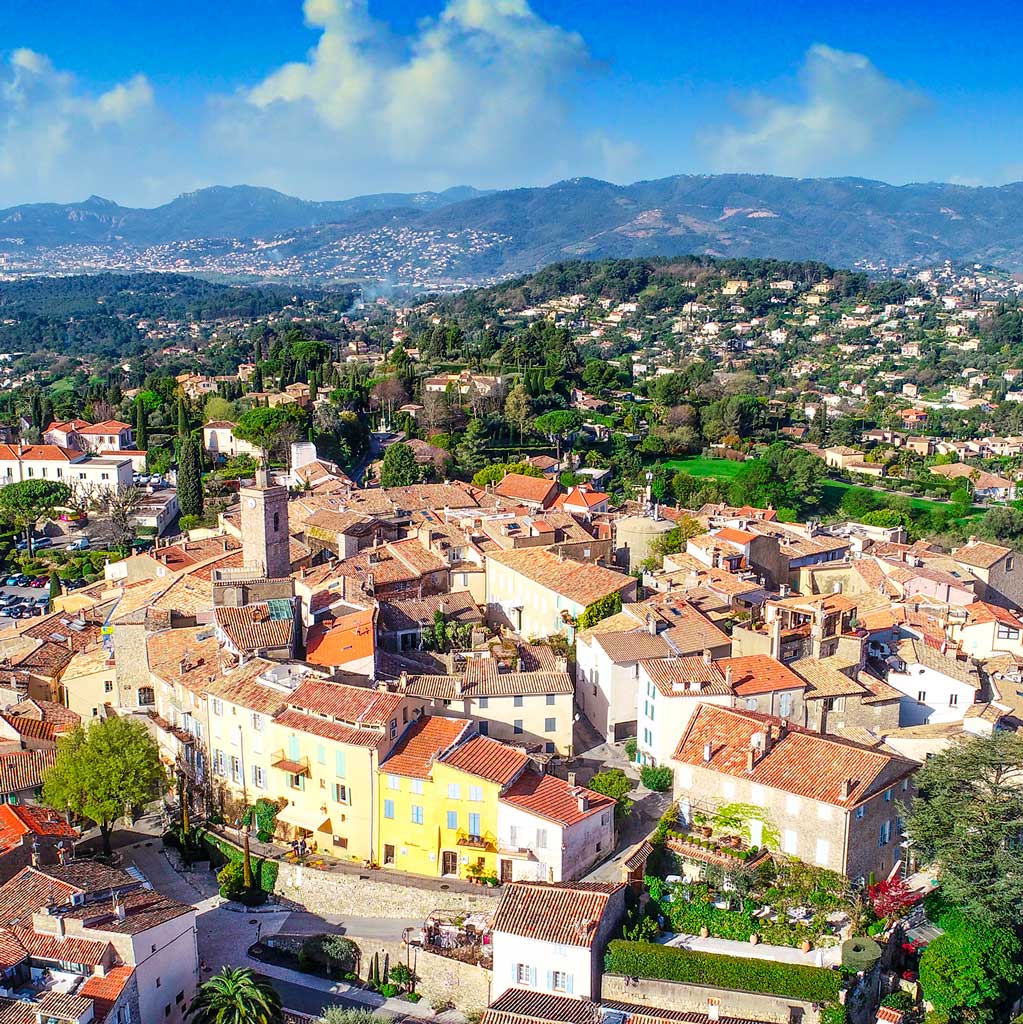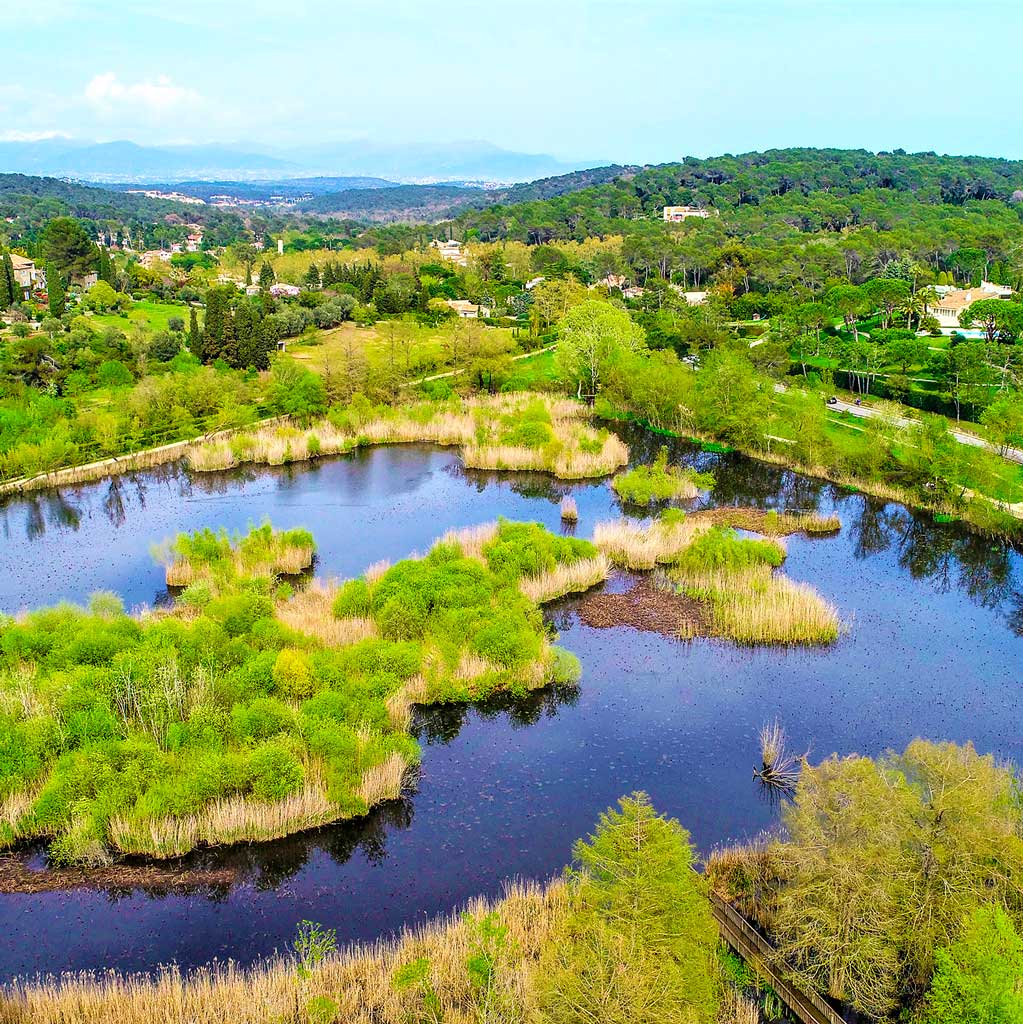The walks
Follow the guide…
From the old village to the Val de Mougins
Starting from the heart of the old village, this walk will take you down a pretty slope with beautiful open views to the Val de Mougins. Formerly known as Les Barraques, this district has developed slowly over the years and today has a lively and animated appearance. On the site, bakery, café, greengrocer and tea room await you for a well-deserved gourmet break. There are also a few shops to tempt shoppers before you slowly make your way back to your starting point.
Find out more
Departure point: Avenue de la Victoire in the old village. Marked trail, easy descent, two difficulty levels with a choice of two trails for the ascent.
Time: 15 minutes / One way.
“Step by step”
The “Step by step” route links Mougins old village to the Mougins-le-Haut district. Over the course of this pretty marked route, you will come across some of the most beautiful natural spaces in the Mougins area: the enchanting Siagne canal with its Pagnolesque atmosphere; the Notre-Dame-De-Vie [Our Lady of Life] chapel right next to the last home of Pablo Picasso; Fontmerle lake, which boasts exceptional flora and fauna and which, in summer, is covered by the largest water lily colony in Europe; and the Valmasque pine and oak forest. A change of scenery guaranteed!
Find out more
Start: from the Place des Patriotes, in the old village.
Time: 1 hour 45 minutes/One way; 6.2 km.
Difficulty: generally easy (sloped path up to the Notre-Dame-de-Vie chapel).
There are carparks dotted along the route at regular intervals, allowing the trail to be shortened or tackled in several stages. Detailed route available from the Tourist Information Centre or on www.mouginstourisme.com.
Along the Siagne Canal
It winds its way through Mougins, between the Saint-Basile and Guillet districts. It meanders through terraces and undergrowth, flows beside the Notre-Dame-de-Vie chapel and the eponymous Provencal farmhouse that was the last home of the master, Pablo Picasso, before approaching Fontmerle lake and the La Valmasque Departmental Park.
There are several possible starting points, but we suggest the one situated close to the Notre-Dame-de-Vie chapel, below. A path takes you there, then you have to turn left towards the Hameau du Guillet.
About twenty minutes of walking and nice views later, at the level of the small bridge, follow the direction “Étang de Fontmerle” which is a few meters higher (small steep climb). You can then walk around the pond and/or stop in the surrounding park for a picnic/snack before returning by the same route. You can also choose the short version via the Chemin de la Chapelle, on the right after the car park, which runs alongside the former home of Pablo Picasso. Translated with www.DeepL.com/Translator (free version)
Find out more
Parking de la chapelle, 501-869 chemin de la Chapelle. For other departure points and options, please ask our travel consultants at the Tourist Office.
Around Fontmerle pond
Ideal for a gentle walk, a moment of relaxation, meditation or a more dynamic jog, the Fontmerle pond enchants the senses. To be discovered without moderation, alone or with the family!
Bordered by twelve hectares of pasture and located a few minutes from the old village on the edge of the La Valmasque Departmental Park, the lake is a remarkable location both for the beauty of its landscapes and for the stunning richness of its flora and fauna.
Between reeds, bulrushes and iris, it houses the largest European colony of Nelumbo nucifera water lilies, originally from Asia.
Another rare feature not to be missed is the thirty-six bald cypresses (toxodium distichum) or swamp cypresses that surround the pond. These are deciduous conifers native to Florida and the marshes near the Gulf of Mexico. In addition, depending on the season, up to 70 species of birds can be found at Fontmerle Pond! Some of them nest there all year round, such as mallards, coots, grebes, moorhens… Other species arrive with spring, such as egrets and herons. As for the ducks dressed in shimmering colours, they prefer to come here to hibernate. Translated with www.DeepL.com/Translator (free version)
Firm favorite :
Manor, my beautiful manor…
Fontmerle lake is overlooked by a hill where stands the
“Manoir de l’Étang” (Lake Manor) Transformed into a charming hotel, this magnificent stone building, where the ivy gives free rein to its imagination, has a rich history. It was built by an English lord at the end of the 19th century. It is rumoured that Rudyard Kipling, author of the “Jungle Book” among others, stayed within these walls. Jean Cocteau and Jean Marais would also have considered creating a cinema city there, a project dear to Marcel Pagnol.
More information
An ambition that was forgotten due to the emergence of Cinecitta in Rome at the same time. But the charm of the manor never ceased to have an effect. At the beginning of the 1950s, Maurice Gridaine, architect for the cinema and creator of the first Palais des Festivals in Cannes, was seduced and bought the building, before undertaking a long renovation to revive its brilliance and its very special character. The world of cinema was not insensitive to this, as was the case of Philippe Labro who came to direct a few films in this place…
In the heart of La Valmasque Departmental Park
Created and managed by the Alpes-Maritimes department, the Valmasque park is a formidable green lung covering some 500 hectares in the communes of Valbonne and Mougins. Composed of three wooded hills alternating with gently shaped valleys, it offers a fitness trail and various walking routes.
The Carton walk
(time: 1½ hours / length: 2.8 km / easy)
A walk offering a variety of atmospheres, through heath, scrubland and forest, where you can see the temporary ponds linked to former clay pits.
→ The Fontmerle walk
(time: 2 hours / length: 4 km / easy)
A beautiful forest walk starting at Fontmerle lake, a preferential spot for watching a multitude of birds. The path rises up through a pine forest where Scots pines grow alongside Aleppo pines, to join up with the Mouginette, sparse undergrowth dotted with orchids.
The Fugueiret walk
(time: 2 hours / length: 4.6 km / easy)
A magnificent walk in the heart of the Valmasque that winds its way through the bushes before penetrating a dense forest where ancient terraces are hidden away. Arriving at the Fugueiret dam with its lush backdrop brings a soft touch of green. Further on, you can see the eagle ferns that turn to earthy tones in the autumn.
The discovery trail
(time: 1 hour / 1.6 km / easy)
An educational route allowing you to set off to discover Mediterranean insects with the aid of 10 interpretation points, with relief panels specifically adapted for the partially-sighted.
The fitness trail
(time: 45 minutes. Length: about 1.4 km. Easy)
A fitness trail laid out near the stadium and that goes around the Clausonnes hill, and that invites you to take physical exercises on the wooden equipment.
Documents
- Map of the Valmasque
- “Step by Step” Flyer
- “Walks in Mougins” Brochure






